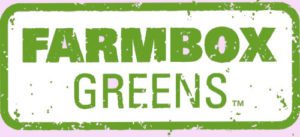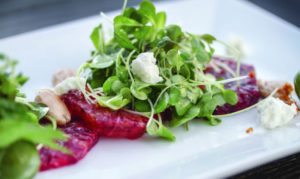
Using Vertical Farming to Supply Locally Grown Produce
As a youth, Dan Albert, owner of Farmbox Greens in Seattle, Washington, worked on a farm in upstate New York. But his past growing experience is a far cry from his current vertical farm operation located in a 500-square-foot detached garage next to his home in a residential neighborhood. Even though he had grown field crops including corn, alfalfa and hay, he had no previous experience producing edible crops.
Albert’s first exposure to vertical farming came in 2008 during a design competition for the U.S. Green Building Council’s annual conference.
“The architecture firm I was working for in 2008 in Seattle, sponsored a team of young designers to develop a conceptual architectural design that met the newly developed Living Building Challenge,” says Albert. “The concept of the competition was to design a carbon neutral building that was self-sufficient. During the development of this design, the vertical farm idea really captivated my interest and became one of the main drivers for this conceptual building.”
The design project Albert worked on won both regional and national awards.
“We came up with this concept for a vertical farm, which at the time we didn’t know was a vertical farm,” he says. “The idea of bringing food production indoors in a greenhouse façade on a building wasn’t really being done per se in 2008. I became friends with Dickson Despommier at Columbia University and got to work with him on a number of other early stage design concepts.”
Albert increasingly received questions from developers about how a vertical farm works, what kind of revenue it could generate, and what is the business model for a vertical farm.
“After two years of talking with people who were excited about these projects, I concluded no one was answering the hard questions about how vertical farm systems work and where are the real efficiencies,” he explains. “Through the process of working on vertical farm projects, I decided I should try growing with a vertical farm.”
Finding the Best Production System
Before Albert made any attempts at growing edible crops he decided to find out what was involved in operating different urban farming systems. He attended the Greenhouse Crop Production & Engineering Design Short Course at the University of Arizona Controlled Environment Agriculture Center. He also did research into different companies and different production systems.

Albert purchased an aeroponic system in 2011 and started a prototype research farm, which he trialed for about eight months.
“It was a total learning curve for me,” he says. “In Seattle, warehouse space is expensive and hard to come by. I set up the aeroponic system in converted office space. It was a lot of trial and error. Initially I was going to grow salad greens because they are a high value product. It is also a crop that is highly perishable.
“I quickly realized that the yield was so little out of this unit that provided 100 square feet of production. But that kind of jump started me to thinking about how to turn this into a business.”
Matching Crops, Production System
As Albert became more comfortable and confident producing edible crops he started to rethink how he was growing.
“I kind of stumbled upon growing microgreens and culinary herbs as a highly perishable, high value product that chefs wanted,” says Albert. “Essentially I was already growing microgreens, but I was letting them continue to the baby green stage at 17 to 20 days. I started to harvest them after 10 to 14 days instead. I pitched the product to a couple of restaurants and all of a sudden people were buying our microgreens. I started selling the crops as Farmbox Greens in 2012.”
Albert says one of the challenges of having a small production space was to determine how to use it to generate the most revenue.
“Even though I had limited space, the intensity of production that I could generate with microgreens enabled me to produce 52 harvests or more a year. It comes down to producing the same thing every week and having the right process in place. It’s a different model from some large greenhouse and vertical farm operations.”
Albert purchased a new home in Seattle in 2012. The property included a detached garage, which he is now using as his production facility. He restarted his operation in February 2013 exclusively producing microgreens and culinary herbs.
Although Albert is still using his original aeroponic system, he redesigned the components and developed a 600-square-foot vertical farm system. Microgreens are grown in trays on a moisture pad. The plants are fertilized with a recirculating nutrient film technique system. The NFT system consists of a pump, a water reservoir and a series of manifolds that deliver the water.
“The system has been modified so that I can grow microgreens efficiently,” Albert says. “I still use the original aeroponic system, but it is not the main focus of my production anymore. I have installed one vertical system that is three levels of production and another that has five levels. I don’t need a lot of vertical height in order to grow multi-levels of microgreens. In the same building there is a harvesting area along with refrigeration and storage space. It is a functioning revenue- generating farm.”
Albert says when he was designing the vertical production system he chose the best equipment he could afford.

“I put in Philips LED Production Modules as the primary lighting source in a stacked arrangement,” he says. “I am using a high efficiency Energy Star heat pump to cool and heat the facility. All of the environmental controls are within the building. Hanna Instruments and Autogrow Systems equipment are used to measure the nutrients and pH. I have a very specific formula for growing microgreens on a small scale. There is no need to operate a huge farm.”
One of the most important aspects of trying to run a sustainable operation, Albert says, is not using any chemical controls for insects and diseases.
“I manage pests and diseases by being vigilant and keeping the facility and equipment clean,” he says. “There is very little substrate for insects and diseases to come in and become established. Also, the crops don’t stay in the facility very long. I grow only what I am going to harvest so that there is no waste.
“I tried to develop a system where, for example, today I am planting for next week’s harvest. I’m basing the planting on what was harvested last week, what I sold and what I’m projecting to sell. What I harvest in the morning is sold out in the afternoon or the next morning. I don’t want to
be holding product. Once you do that it hurts the quality, hurts the flavor and the overall look of the microgreens. It’s all about harvest, package, cool and deliver and then do it again.”
Expanding Customer Base
Farmbox Greens’ customer base includes 50 local restaurants that purchase product on a weekly or biweekly basis depending on time of year.
“The restaurants vary from very high end to everything in between,” Albert explains. “The food is very high quality, but it is not all at a premium price point. Some people hear microgreens and they just assume it’s going to be expensive, but that’s not always the case. These are restaurants that care about local, high quality food.”
Albert produces 20 different varieties of microgreens and herbs on a weekly basis.
“When it comes to microgreens, there are certain flavor profiles that chefs are interested in,” he says. “I try to have a wide variety available, including peppery, crunchy and something lemony like sorrel or baby kale. I could grow a wider variety of crops, but on the herb side it comes down to just a few basics, including basil, cilantro and sorrel.”
Farmbox Greens also participates in four year- round farmers markets.
“I have been really focused on building our customer base at the farmers markets,” he adds. “These markets are really well attended in Seattle.”
Albert says one of the biggest changes is the percentage of sales going to his wholesale customer base via a retail grocery store partner.
His newest grocery store customer is Metropolitan Market (www.metropolitan-market. com). “It’s a regional grocery store with six stores in the Seattle area,” says Albert. “The company has been a big part of our transition to retail.”

(Photo: Farmbox Greens)
Another company that Albert works with is Marx Foods (www.marxfoods.com). “This company is a local food distributor, but it also has retail space, so I sell some of my product through its store,” he says. “Marx Foods also distributes to AmazonFresh, which is a grocery delivery service. Marx wants to promote local, high quality products in its store and online. It is very committed to supporting local businesses and selling a variety of products including artisanal foods.”
Planning Ahead
Albert believes his company has done well in terms of being able to meet demand. “I have been able to balance what I’m growing with what I’m selling,” he shares.
“The next step is to identify the scale of production that I need and the customer and crop mix. My company can get bigger, but microgreens aren’t this unlimited market. It’s about cash on hand to build out the production facility. It’s about costs. It’s about efficiency. It’s about customers.”
Albert’s goal this year is to maximize his production capacity in the current space available. “I am preparing to expand,” he says. “It’s been a good thing where we have been able to adjust where we are selling our produce and that has helped with the bottom line as well.
“We are nearly maxed out on a weekly basis as far as production in this facility. We have enough production where we can take care of our customers and still have a little flexibility to take on some new customers. What we are looking at now is what is the next big step? Who are the people we are going to sell to at the next level? And that really goes to retail and wholesale. Once we get those set up then we will move on.”
Albert is interested in working with investors to expand his business. “At this point the costs are such that to do the next step on our own, while possible, it could be done more expediently if we had the right investors, the right set of key members to help us with that process,” he says. “We would be willing to work with the right group to scale up the business.
“What we are looking at are a couple of buyers that would be willing to purchase a significant amount of produce and guarantee that through a contract that would make it a no-brainer to expand the business. Previously we have been taking small steps by adding one new customer at a time. Now we are looking to make that big jump. Once you have a customer that is willing to commit to a big chunk of revenue that is the kind of thing that lenders and investors are looking for. That is what we are working towards.”
For more information, contact Farmbox Greens at info@ farmboxgreens.com or go to www. farmboxgreens.com. Some of the information presented in this article first appeared in Urban Ag News Issue 9, April 2015, www.urbanagnews.com.


 Video Library
Video Library 




















